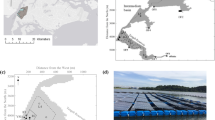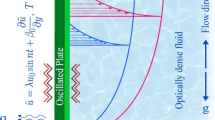Abstract
This paper considers fluid mixing driven by inflows connected to a circular shallow lake using a numerical framework consisting of a shallow water hydrodynamic model and a passive particle-tracking model. With the flow field driven by alternate inflows predicted by a shallow water model, particle trajectories are traced out using a particle tracking model. The horizontal fluid mixing dynamics are then interpreted using dynamics system analysis approaches including finite-time Lyapunov exponent (FTLE) and Lagrangian coherent structure (LCS). From the simulation results, it is confirmed that periodic inflows are able to create a weak dynamic system in an idealised circular lake, with the particle dynamics controlled by a single dimensionless parameter associated with the inflow duration. The mixing and transport property of the lake changes from regular to chaotic as the value of the dimensionless parameter increases until global chaotic particle dynamics is achieved. By further analysing the advection of particles injected continuously to the inflows (freshwater), the fate of “freshwater” particles in a “polluted” lake is tracked and revealed. The results provide useful guidance for engineering applications, i.e., transferring freshwater from rivers to improve the water quality in polluted water bodies such as lakes. The presented approach will be able to facilitate the design of ‘optimised’ schemes for such engineering implementation.
Similar content being viewed by others
References
Liu X. B., Peng W. Q., He G. J. et al. A coupled model of hydrodynamics and water quality for Yuqiao reservoir in Haihe river basin [J]. Journal of Hydrodynamics, 2008, 20(5): 574–582.
Liang D., Wu X. A random walk simulation of scalar mixing in flows through submerged vegetations [J]. Journal of Hydrodynamics, 2014, 26(3): 343–350.
Zhang C., Gao X., Wang L. et al. Analysis of agricultural pollution by flood flow impact on water quality in a reservoir using a three-dimensional water quality model [J]. Journal of Hydroinformatics, 2013, 15(4): 1061–1072.
Kranenburg C. Wind-driven chaotic advection in a shallow model lake [J]. Journal of Hydraulic Research, 1992, 30(1): 29–46.
Liang Q., Borthwick A. G. L., Taylor P. H. Wind-induced chaotic advection in shallow flow geometries. Part I: Circular basins [J]. Journal of Hydraulic Research, 2006, 44(2): 170–179.
Liang Q., Borthwick A. G. L., Taylor P. H. Wind-induced chaotic advection in shallow flow geometries. Part II: Non-circular basins [J]. Journal of Hydraulic Research, 2006, 44(2): 180–188.
Károlyi G., Pattantyús-Ábrahám M., Krámer T. et al. Finite-size Lyapunov exponents: A new tool for lake dynamics [J]. ICE-Engineering and Computational Mechanics, 2010, 163(4): 251–259.
Lee W. K., Borthwick A. G. L., Taylor P. H. Wind-induced chaotic mixing in a two-layer density-stratified shallow flow [J]. Journal of Hydraulic Research, 2014, 52(2): 219–227.
García-Garrido V. J., Ramos A., Mancho A. M. et al. A dynamical systems perspective for a real-time response to a marine oil spill [J]. Marine pollution bulletin, 2016, 112(1–2): 201–210.
Liao S. J. On the clean numerical simulation (CNS) of chaotic dynamic systems [J]. Journal of Hydrodynamics, 2017, 29(5): 729–747.
Aref H. Stirring by chaotic advection [J]. Journal of Fluid Mechanics, 1984, 143: 1–21.
Benson D. A., Pankavich S., Bolster D. On the separate treatment of mixing and spreading by the reactive-particle-tracking algorithm: An example of accurate upscaling of reactive Poiseuille flow [J]. Advances in Water Resources, 2019, 123: 40–53.
Xie T., Xu C. Numerical and experimental investigations of chaotic mixing behavior in an oscillating feedback micromixer [J]. Chemical Engineering Science, 2017, 171: 303–317.
Aref H. The development of chaotic advection [J]. Physics of Fluids, 2002, 14(4): 1315–1325.
Koshel K. V., Prants S. V. Chaotic advection in the ocean [J]. Physics-Uspekhi, 2006, 49(11): 1151–1178.
Liang Q., Borthwick A. G. L. Adaptive quadtree simulation of shallow flows with wet-dry fronts over complex topography [J]. Computers and Fluids, 2009, 38(2): 221–234.
Smith S. D. Coefficients for sea surface wind stress, heat flux, and wind profiles as a function of wind speed and temperature [J]. Journal of Geophysical Research: Oceans, 1988, 93(C12): 15467–15472.
Xia X., Liang Q. A new efficient implicit scheme for discretising the stiff friction terms in the shallow water equations [J]. Advances in Water Resources, 2018, 117: 87–97.
Shadden S. C., Lekien F., Marsden J. E. Definition and properties of Lagrangian coherent structures from finite-time Lyapunov exponents in two-dimensional aperiodic flows [J]. Physica D: Nonlinear Phenomena, 2005, 212(3): 271–304.
Haller G., Yuan G. Lagrangian coherent structures and mixing in two-dimensional turbulence [J]. Physica D: Nonlinear Phenomena, 2000, 147(3): 352–370.
Mancho A. M., Small D., Wiggins S. A tutorial on dynamical systems concepts applied to Lagrangian transport in oceanic flows defined as finite time data sets: Theoretical and computational issues [J]. Physics Reports, 2006, 437(3): 55–124.
Shadden S. C., Lekien F., Paduan J. D. et al. The correlation between surface drifters and coherent structures based on high-frequency radar data in Monterey Bay [J]. Deep Sea Research Part II: Topical Studies in Oceanography, 2009, 56(3–5): 161–172.
Wiggins S. Normally hyperbolic invariant manifolds in dynamical systems [M]. Now York, USA: Springer Science and Business Media, 1994.
Haller G. A variational theory of hyperbolic Lagrangian coherent structures [J]. Physica D: Nonlinear Phenomena, 2011, 240(7): 574–598.
Liang Q., Borthwick A. G. L., Taylor P. H. Chaotic mixing in a basin due to a sinusoidal wind field [J]. International Journal for Numerical Methods in Fluids, 2005, 47(8): 871–877.
Guo H., He W., Peterka T. et al. Finite-time Lyapunov exponents and Lagrangian coherent structures in uncertain unsteady flows [J]. IEEE Transactions on Visualization and Computer Graphics, 2016, 22(6): 1672–1682.
Sieber M., Ostermann F., Woszidlo R. et al. Lagrangian coherent structures in the flow field of a fluidic oscillator [J]. Physical Review Fluids, 2016, 1(5): 050509.
Cimatoribus A. A., Lemmin U., Barry D. A. Tracking Lagrangian transport in Lake Geneva: A 3D numerical modeling investigation [J]. Limnology and Oceanography, 2019, 64(3): 1252–1269.
Li Y., Tang C., Wang C. et al. Improved Yangtze River diversions: are they helping to solve algal bloom problems in Lake Taihu, China? [J]. Ecological Engineering, 2013, 51: 104–116.
Author information
Authors and Affiliations
Corresponding author
Additional information
Project supported by the National Natural Science Foundation of China (Grant No. 11371117).
Biography: Cheng-hua Dang (1967–), Female, Master, Senior Engineer
Rights and permissions
About this article
Cite this article
Dang, Ch., Wang, J. & Liang, Q. Inflows/outflows driven particle dynamics in an idealised lake. J Hydrodyn 31, 873–886 (2019). https://doi.org/10.1007/s42241-019-0070-9
Received:
Revised:
Accepted:
Published:
Issue Date:
DOI: https://doi.org/10.1007/s42241-019-0070-9




